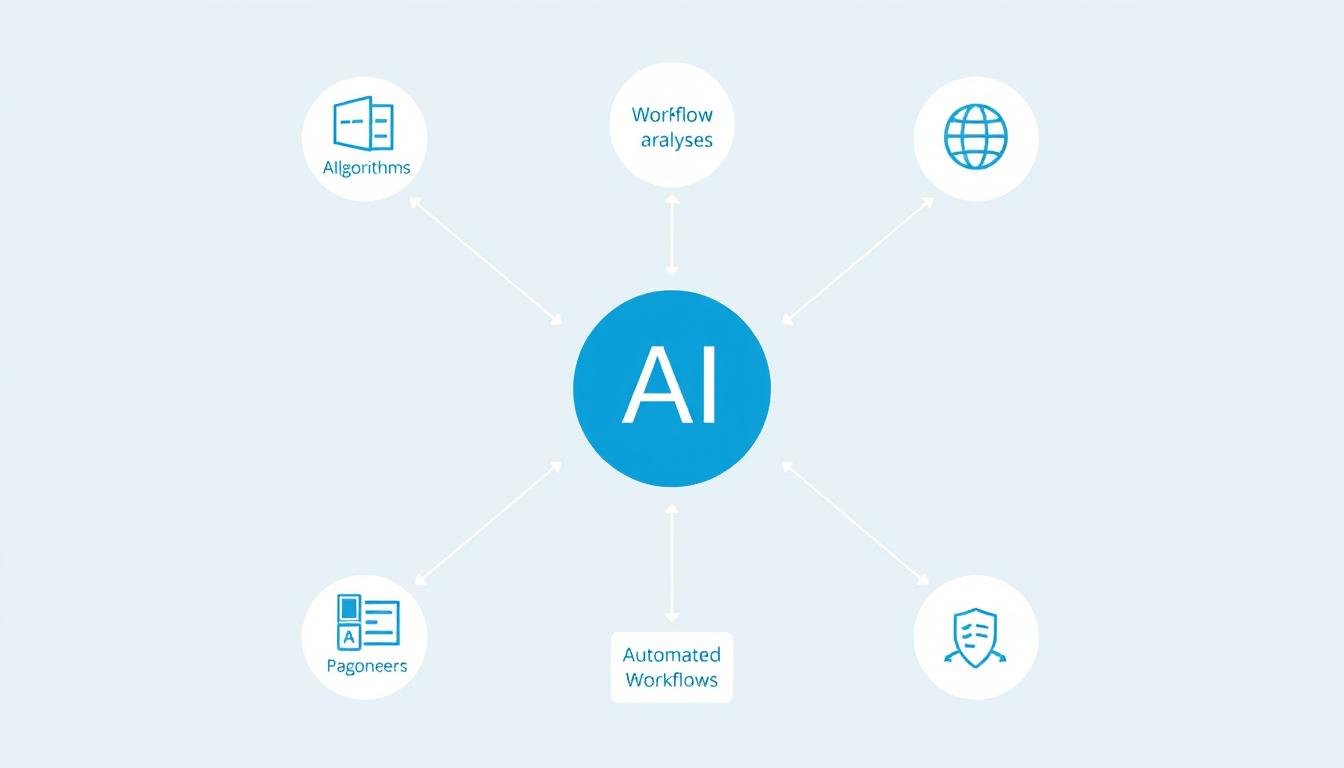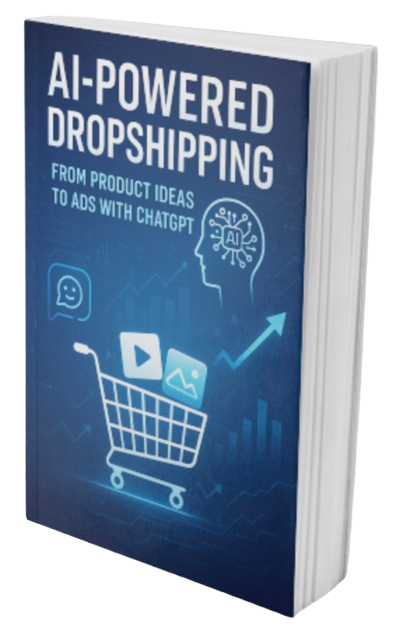In today’s fast-paced business environment, organizations are constantly seeking ways to streamline operations, reduce costs, and enhance productivity. AI Automation & Workflows represent a revolutionary approach to achieving these goals, fundamentally changing how businesses operate by introducing intelligence, adaptability, and real-time decision-making to process automation. This comprehensive guide explores how artificial intelligence is transforming traditional workflows, providing you with actionable insights to implement these powerful technologies in your organization.
What is AI-Driven Workflow Automation?
AI workflow automation combines artificial intelligence technologies with traditional automation to streamline business processes and tasks across systems and departments. Unlike conventional automation based on rigid, predefined rules, AI-driven workflow automation learns through experience, continuously improving its performance over time.
This intelligent approach enables the automation of complex processes that require understanding context, making decisions, and taking appropriate actions across multiple systems without human intervention. By leveraging machine learning, natural language processing, and other AI technologies, these systems can handle tasks that previously required human judgment and expertise.
Core Technologies Powering AI Workflow Automation
Machine Learning (ML)
ML algorithms allow systems to learn from historical data and improve their performance over time. By recognizing patterns in workflow execution, these models can optimize processes automatically, reducing time and effort.
Natural Language Processing (NLP)
NLP enables automation systems to understand and process human language, facilitating more natural interactions between employees and automated systems. This technology bridges the communication gap between humans and machines.
Robotic Process Automation (RPA)
RPA manages repetitive, rule-based tasks across different applications. When enhanced with AI capabilities, RPA becomes more flexible and can handle exceptions and adapt to complex scenarios effectively.
Advanced Analytics
Predictive algorithms detect workflow bottlenecks, anticipate issues before they occur, and provide real-time, data-driven recommendations for process improvements.
These technologies work together to create intelligent workflows that understand context, make decisions, and take appropriate actions autonomously while maintaining security and compliance standards. This integration simplifies complex processes while addressing concerns like safety and regulatory requirements.
Key Benefits of AI Workflow Automation

Benefits of AI Workflow Automation
- Significant reduction in human errors (up to 90% in data processing tasks)
- 24/7 operational capability without fatigue or performance degradation
- Cost optimization through reduced manual labor and improved resource allocation
- Increased processing speed (tasks completed up to 70% faster than manual methods)
- Enhanced scalability to handle volume fluctuations without additional resources
- Improved compliance through consistent application of rules and regulations
- Better customer and employee experience through faster response times
- Data-driven insights from automated analytics and reporting
Challenges to Consider
- Initial implementation costs and resource requirements
- Potential resistance to change from employees
- Need for ongoing maintenance and updates
- Data quality dependencies for optimal performance
- Integration complexities with legacy systems
- Security and privacy considerations
- Ethical implications of automated decision-making
Transformative Impact Across Organizations
Operational Efficiency
AI-powered tools dramatically reduce time spent on routine tasks by up to 40%, allowing employees to focus on higher-value work requiring creativity and strategic thinking. This translates to significant productivity gains and cost savings regardless of business size.
Enhanced Support Experience
Employees receive immediate assistance through conversational interfaces rather than navigating multiple systems or waiting for IT staff. Automation streamlines follow-up actions across platforms, reducing downtime and keeping staff focused on core responsibilities.
Improved Scalability
AI workflow automation enables businesses to scale operations efficiently without proportional increases in staffing. The self-learning capabilities of these systems mean they continuously optimize workflows based on usage patterns, becoming more effective over time.
Ready to explore how AI can transform your workflows?
Discover the top tools that are helping businesses implement AI automation successfully.
Traditional vs. AI-Enhanced Workflows
| Aspect | Traditional Workflows | AI-Enhanced Workflows |
| Decision Making | Based on predefined rules and conditions | Intelligent decisions based on data analysis and learning |
| Adaptability | Requires manual updates to accommodate changes | Self-adjusts based on new patterns and scenarios |
| Error Handling | Stops at exceptions, requires human intervention | Can handle exceptions and learn from them |
| Data Processing | Limited to structured data in specific formats | Can process unstructured data (text, images, etc.) |
| Optimization | Manual analysis and periodic updates | Continuous improvement through machine learning |
| User Interaction | Form-based, rigid interfaces | Natural language interfaces, conversational |
| Scalability | Linear scaling requiring proportional resources | Efficient scaling with minimal additional resources |

Real-World Use Cases Across Industries
“AI workflow automation is not just about cost savings—it’s about fundamentally reimagining how work gets done. Organizations that successfully implement these technologies are seeing 40-60% improvements in process efficiency while simultaneously enhancing quality and compliance.”
– McKinsey Global Institute
Financial Services
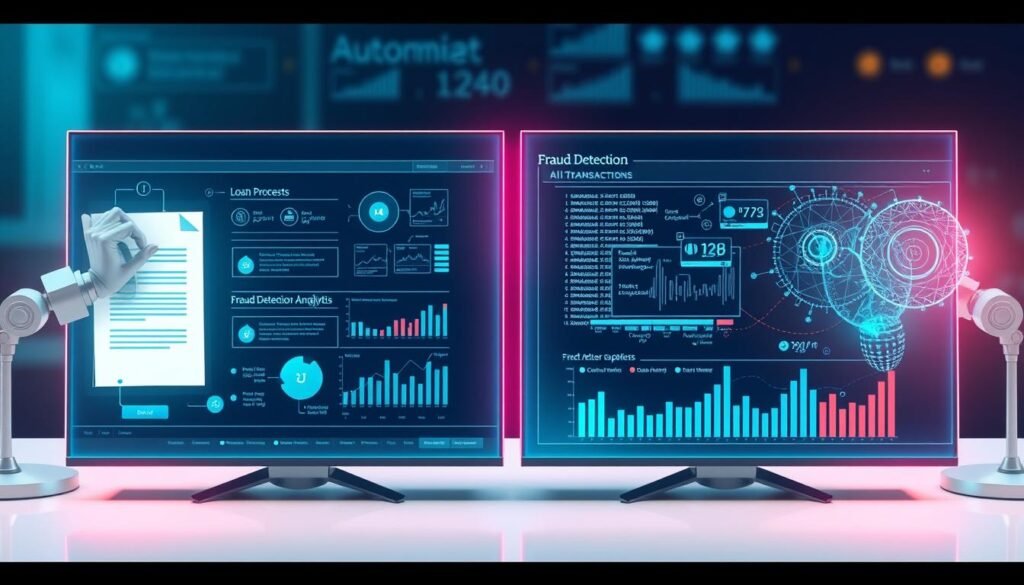
Financial institutions are leveraging AI workflow automation to transform operations across multiple domains:
Loan Processing
AI-powered systems have reduced loan processing time from days to minutes while maintaining risk standards. A leading bank reported a 70% reduction in processing time and a 50% decrease in operational costs after implementing AI workflow automation for loan underwriting.
Fraud Detection
Machine learning algorithms analyze transaction patterns in real-time, identifying potential fraud with 95% accuracy. These systems can process millions of transactions daily, flagging suspicious activities that would be impossible for human analysts to detect at scale.
Healthcare

The healthcare industry is embracing AI workflow automation to improve patient care and operational efficiency:
Patient Scheduling and Management
AI systems have reduced appointment no-shows by 27% through intelligent scheduling and automated reminders. These systems analyze historical data to optimize appointment slots and staff allocation, improving resource utilization by up to 35%.
Claims Processing
Healthcare providers using AI for claims processing report 30-40% faster processing times and a 55% reduction in errors. The technology automatically extracts information from submitted documents and routes claims appropriately, significantly reducing administrative burden.
Manufacturing
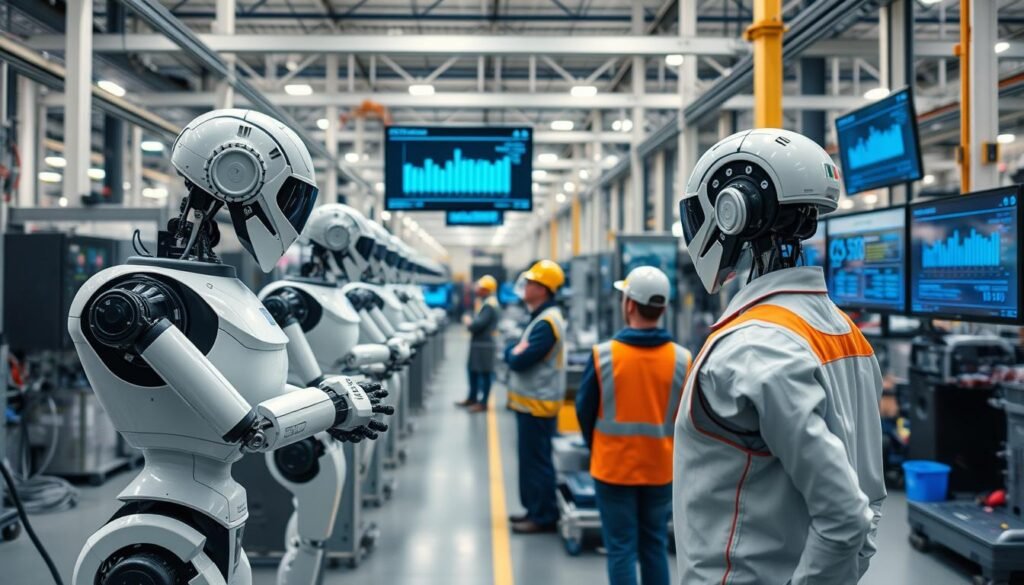
Manufacturing companies are achieving remarkable results through AI workflow automation:
Predictive Maintenance
AI-driven predictive maintenance has reduced unplanned downtime by up to 50% in manufacturing facilities. By analyzing sensor data and equipment performance patterns, these systems can predict failures before they occur, allowing for scheduled maintenance that minimizes disruption.
Quality Control
Computer vision systems powered by AI have improved defect detection rates by 90% compared to manual inspection. These automated quality control workflows can process thousands of items per hour with consistent accuracy, significantly reducing defect rates and customer returns.
See how these solutions could work for your industry
Get access to industry-specific implementation guides and case studies.
Step-by-Step Implementation Guide
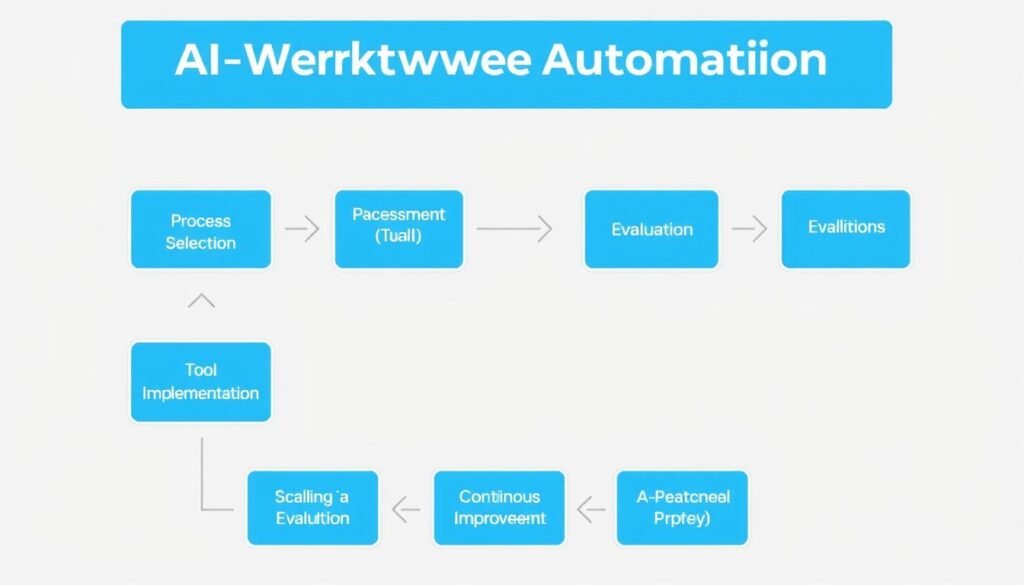
Implementing AI workflow automation requires a structured approach to ensure success. Follow these steps to transform your business processes effectively:
-
Assess Current Workflows and Identify Opportunities
Begin by documenting existing processes and identifying pain points, inefficiencies, and bottlenecks. Look for repetitive, time-consuming tasks that follow predictable patterns. Prioritize processes based on potential impact, complexity, and strategic importance.
-
Define Clear Objectives and Success Metrics
Establish specific, measurable goals for your automation initiative. These might include reducing processing time by a certain percentage, decreasing error rates, or improving customer satisfaction scores. Clear metrics will help you evaluate success and justify investment.
-
Select the Right AI Technologies and Tools
Choose appropriate technologies based on your specific needs. Consider factors such as integration capabilities with existing systems, scalability, security features, and total cost of ownership. Evaluate whether no-code platforms, enterprise solutions, or custom development best suits your requirements.
-
Start with a Pilot Project
Implement automation for a single process or department first. This allows you to test the approach, identify challenges, and demonstrate value before scaling. Select a process that offers visible benefits but isn’t mission-critical to minimize risk.
-
Prepare Your Data
Ensure data quality and accessibility. AI systems require clean, structured data to function effectively. Identify data sources, establish data governance procedures, and implement necessary integrations between systems.
-
Develop and Test the Automated Workflow
Design the automated workflow, incorporating AI capabilities where appropriate. Test thoroughly in a controlled environment, comparing results against your established success metrics. Refine the workflow based on test results.
-
Implement Change Management
Prepare your organization for the change. Communicate benefits clearly, provide comprehensive training, and address concerns proactively. Involve key stakeholders throughout the process to build buy-in and support.
-
Deploy and Monitor
Roll out the automated workflow and establish monitoring systems to track performance. Be prepared to make adjustments as needed based on real-world performance and feedback.
-
Scale and Expand
Once your pilot is successful, expand automation to additional processes and departments. Apply lessons learned from your initial implementation to improve future deployments.
-
Continuously Improve
Regularly review and optimize your automated workflows. AI systems improve with more data and usage, so establish processes for ongoing refinement and enhancement.
Sample Automation Script
# Basic Python script for document processing workflow automationimport pandas as pdfrom sklearn.feature_extraction.text import TfidfVectorizerfrom sklearn.naive_bayes import MultinomialNB# Load and prepare training datatraining_data = pd.read_csv(‘document_categories.csv’)vectorizer = TfidfVectorizer(max_features=1000)X_train = vectorizer.fit_transform(training_data[‘document_text’])y_train = training_data[‘category’]# Train document classifierclassifier = MultinomialNB()classifier.fit(X_train, y_train)# Function to process new documentsdef process_document(document_text): # Vectorize the document doc_vector = vectorizer.transform([document_text]) # Classify the document category = classifier.predict(doc_vector)[0] # Route document based on classification if category == ‘invoice’: return route_to_accounting(document_text) elif category == ‘support_request’: return route_to_customer_service(document_text) elif category == ‘application’: return route_to_processing(document_text) else: return route_to_review(document_text)# Document routing functionsdef route_to_accounting(text): # Extract invoice details and send to accounting system # [Implementation details here] return “Document routed to accounting”def route_to_customer_service(text): # Create support ticket and assign priority # [Implementation details here] return “Support ticket created”def route_to_processing(text): # Process application and update database # [Implementation details here] return “Application processed”def route_to_review(text): # Queue for human review # [Implementation details here] return “Document queued for review”
Need help implementing AI workflow automation?
Common Challenges and Mitigation Strategies

While AI workflow automation offers tremendous benefits, organizations often encounter challenges during implementation. Understanding these obstacles and having strategies to address them is crucial for success.
Technical Challenges
Data Quality and Integration Issues
Challenge: AI systems require high-quality, accessible data to function effectively. Many organizations struggle with siloed, inconsistent, or incomplete data.
Solution: Implement data governance frameworks, cleansing processes, and integration solutions before launching AI initiatives. Consider starting with processes that have more structured data available.
Legacy System Integration
Challenge: Connecting AI automation tools with existing legacy systems can be complex and resource-intensive.
Solution: Use API-based integration approaches or middleware solutions designed for legacy systems. Consider phased modernization of critical systems that will interact frequently with AI workflows.
Organizational Challenges
Resistance to Change
Challenge: Employees often worry about job security and disruption to familiar workflows when automation is introduced.
Solution: Focus on transparent communication that emphasizes how AI will augment rather than replace human workers. Involve employees in the design process and provide comprehensive training and support.
Skill Gaps
Challenge: Many organizations lack the internal expertise to implement and maintain AI systems effectively.
Solution: Invest in training for existing staff, consider strategic hiring, or partner with external experts. No-code AI platforms can also help bridge skill gaps by making automation more accessible.
Strategic Challenges
Unclear ROI and Business Case
Challenge: Quantifying the return on investment for AI initiatives can be difficult, making it hard to secure funding and support.
Solution: Start with well-defined pilot projects that have measurable outcomes. Document both tangible benefits (cost savings, time reduction) and intangible benefits (improved quality, enhanced customer experience).
Governance and Compliance
Challenge: AI systems raise complex questions about accountability, transparency, and compliance with regulations.
Solution: Establish clear governance frameworks for AI usage. Implement monitoring and auditing capabilities to ensure automated decisions align with regulatory requirements and ethical standards.
“The most successful AI automation initiatives are those that balance technological capabilities with human needs. Organizations must address both the technical and people aspects of change to realize the full potential of these powerful technologies.”
– Deloitte Digital Transformation Report
5 Actionable Tips for Successful AI Workflow Automation Adoption
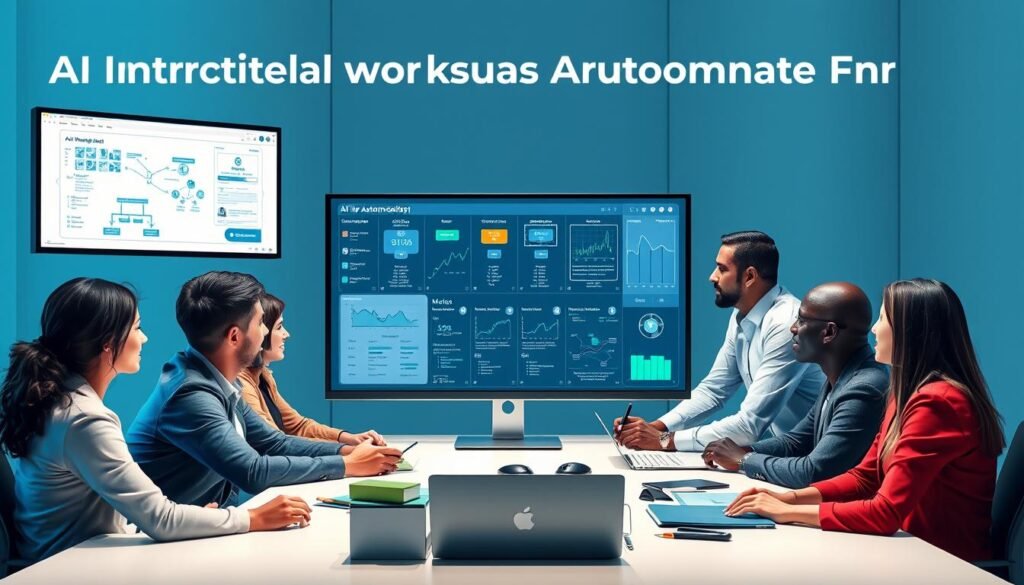
1. Start with High-Impact, Low-Complexity Processes
Begin your automation journey with processes that offer significant benefits but are relatively straightforward to automate. Look for repetitive tasks with clear rules and high volume. These “quick wins” build momentum and demonstrate value early.
2. Involve End Users Throughout the Process
Engage the people who currently perform the tasks you’re automating. Their insights are invaluable for understanding nuances and edge cases. Involving users from the beginning also increases adoption and reduces resistance to change.
3. Design for Human-AI Collaboration
The most effective automation solutions combine AI capabilities with human judgment. Design workflows where AI handles routine aspects while humans manage exceptions and complex decisions. This approach maximizes both efficiency and quality.
4. Establish Clear Governance and Oversight
Create frameworks for monitoring automated decisions and processes. Implement regular audits and reviews to ensure accuracy, compliance, and alignment with business objectives. Clear governance builds trust and ensures responsible AI use.
5. Invest in Continuous Learning and Improvement
AI workflow automation is not a “set and forget” solution. Allocate resources for ongoing optimization, regular reviews of performance metrics, and updates to reflect changing business needs. This commitment ensures long-term value and adaptability.
Top AI Workflow Automation Tools
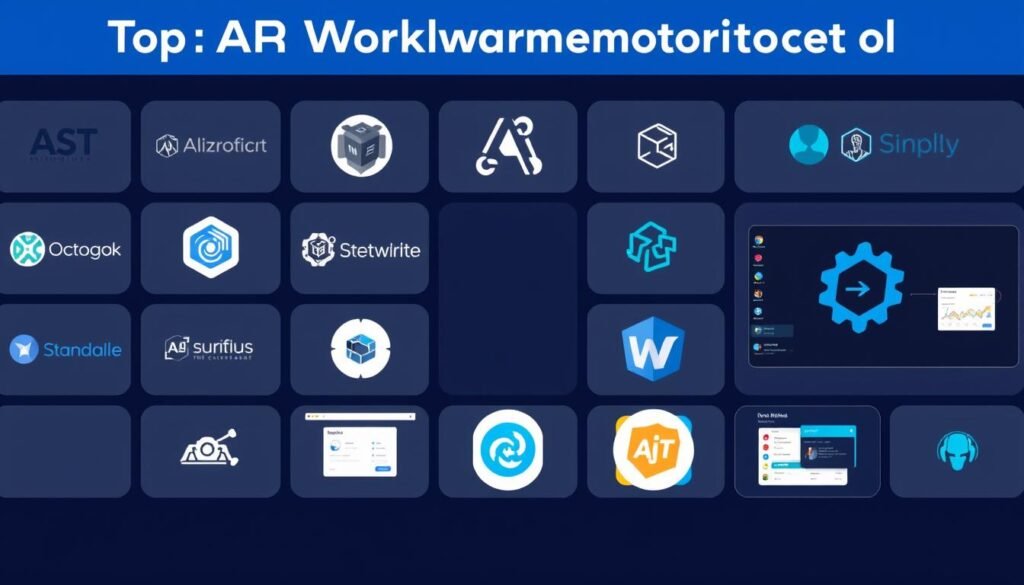
Selecting the right tools is crucial for successful AI workflow automation. Here’s a curated list of leading solutions to consider for your implementation:
{parse:example.com/ai-workflow-tools}
Future Trends in AI Workflow Automation

The landscape of AI workflow automation continues to evolve rapidly. Understanding emerging trends can help organizations prepare for future developments and maintain competitive advantage.
Self-Optimizing Systems
The next generation of AI workflow automation will feature systems that continuously analyze their own performance and automatically implement improvements. These self-optimizing workflows will require minimal human oversight, adjusting to changing conditions and requirements in real-time. Organizations can expect up to 30% additional efficiency gains from these advanced systems compared to current AI automation solutions.
Federated Learning and Privacy-Preserving AI
As data privacy regulations become more stringent, new approaches to AI training are emerging. Federated learning allows AI models to be trained across multiple decentralized devices or servers holding local data samples, without exchanging the data itself. This enables organizations to develop powerful AI workflows while maintaining strict data privacy and compliance with regulations like GDPR and CCPA.
Explainable AI for Transparent Workflows
As AI takes on more complex decision-making roles in workflows, the ability to explain how and why decisions are made becomes crucial. Explainable AI (XAI) technologies are advancing rapidly, providing clear insights into automated decisions. This transparency builds trust, facilitates regulatory compliance, and enables more effective human-AI collaboration in critical processes.
Ethical Considerations and Responsible Automation
“As AI becomes more deeply integrated into business workflows, organizations must consider not just what can be automated, but what should be automated. Ethical frameworks that balance efficiency with fairness, transparency, and human well-being will be essential for sustainable AI adoption.”
– World Economic Forum, Future of Jobs Report
Organizations implementing AI workflow automation must address several key ethical considerations:
Bias and Fairness
AI systems can perpetuate or amplify biases present in training data. Implementing regular audits and diverse training datasets can help ensure automated workflows make fair decisions across different demographic groups.
Transparency and Accountability
Establishing clear lines of accountability for automated decisions is essential. Organizations should maintain appropriate human oversight and ensure stakeholders understand how AI systems influence important processes.
Job Displacement and Reskilling
While automation creates new opportunities, it also transforms existing roles. Responsible implementation includes planning for workforce transitions, investing in reskilling programs, and creating new roles that leverage uniquely human capabilities.
Data Privacy and Security
AI workflows often process sensitive information. Robust data governance frameworks, privacy-by-design approaches, and strong security measures are essential for responsible automation.
Conclusion: Embracing the AI Workflow Revolution

AI Automation & Workflows represent a fundamental shift in how organizations operate, offering unprecedented opportunities for efficiency, innovation, and competitive advantage. By combining the analytical power of artificial intelligence with the systematic approach of workflow automation, businesses can transform operations across departments and industries.
The journey toward AI-powered workflow automation is not without challenges, but organizations that approach implementation strategically—starting with clear objectives, selecting appropriate technologies, and addressing both technical and human factors—can achieve remarkable results. As AI capabilities continue to advance, the potential for automation will only grow, creating new possibilities for businesses willing to embrace this transformative technology.
Whether you’re just beginning to explore AI workflow automation or looking to expand existing initiatives, the time to act is now. Organizations that successfully implement these technologies today will be well-positioned to thrive in an increasingly competitive and fast-paced business environment.
💼 Build Your AI-Powered Income
Turn your ideas into income with these bestselling guides:
🌟 Ready to Build Your AI Income Stream?
You’ve learned the tools — now master the strategies!
Explore our exclusive AI Side Hustle & Passive Income eBooks to start earning smarter with ChatGPT, Canva, and automation tools.
🚀 Connect with SmartAIEarn
Join our growing AI and digital innovation community — explore smarter tools, automation hacks, and new income ideas that help you earn more, work less, and scale fast.
Explore More ⚡